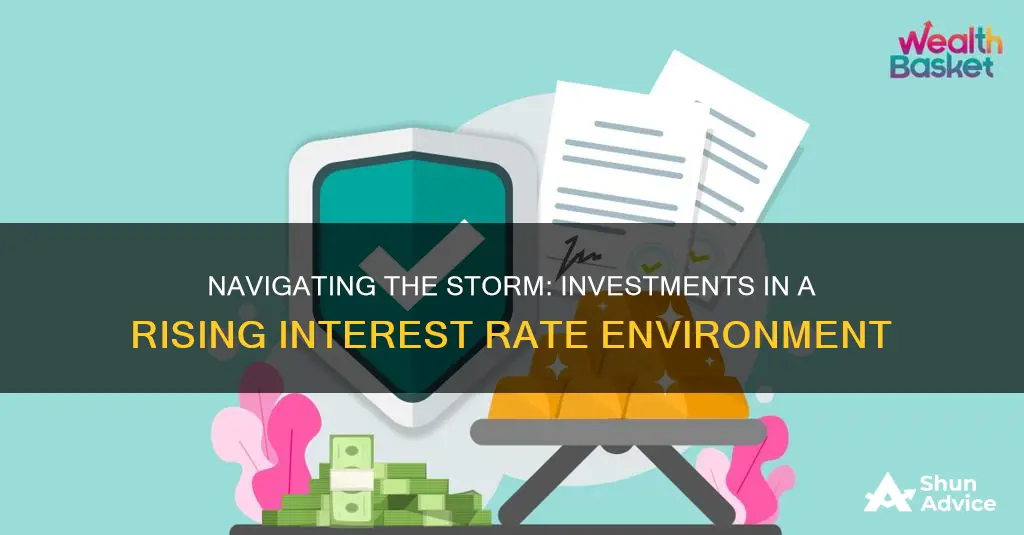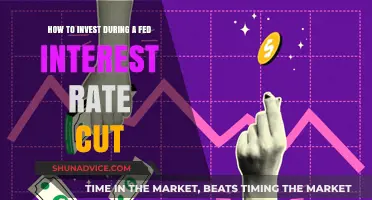
In a rising interest rate environment, investors often seek strategies to navigate the changing market dynamics. Understanding the correlation between various investments and interest rates is crucial for making informed decisions. This paragraph will explore the relationship between different asset classes and how they respond to rising interest rates, providing insights into potential investment opportunities and risks during such economic shifts.
What You'll Learn
- Bonds and Fixed Income: Prices fall as rates rise, impacting bond yields
- Stocks and Equities: Higher rates can reduce corporate profits, affecting stock prices
- Real Estate: Property values may decline, impacting mortgage rates and investments
- Commodities: Agricultural and energy prices can be affected by interest rate changes
- Currencies: Currency values fluctuate with interest rate differentials and economic policies

Bonds and Fixed Income: Prices fall as rates rise, impacting bond yields
As interest rates rise, the value of existing bonds and fixed-income securities tends to decrease, a phenomenon that can significantly impact investors' portfolios. This inverse relationship between bond prices and interest rates is a fundamental concept in fixed-income investing. When central banks or financial institutions increase interest rates, the cost of borrowing money becomes more expensive, and as a result, the demand for bonds, which offer fixed returns, tends to drop. This shift in demand leads to a decrease in bond prices, as sellers are forced to accept lower prices to attract buyers.
Bonds are essentially loans made by investors to governments or corporations. When you buy a bond, you are essentially lending money to the issuer, who promises to pay you a fixed amount of interest (coupon) at regular intervals and repay the principal amount at maturity. In a rising interest rate environment, new bonds issued will offer higher yields to compensate investors for the increased risk of inflation and potential future rate hikes. As a result, older bonds with lower coupon rates become less attractive, and their prices fall to make them more competitive.
The impact of rising interest rates on bond yields is particularly notable for long-term bonds. As rates increase, the difference between the yield on new bonds and the yield on existing bonds becomes more pronounced. For instance, if the central bank raises rates by 1%, a 10-year bond with a 3% coupon might see its yield increase to 4%. In this scenario, investors would be willing to pay less for the older bond, causing its price to decline. This effect is more pronounced for longer-dated bonds, as they are more sensitive to changes in interest rates over time.
Investors should be cautious when the interest rate environment is changing, as it can lead to significant price fluctuations in bond portfolios. Diversification is key during such periods. Holding a mix of bonds with varying maturities and credit ratings can help mitigate the risks associated with rising rates. For example, shorter-term bonds are less sensitive to rate changes and can provide a more stable income stream during periods of rising rates.
In summary, bonds and fixed-income securities are highly sensitive to changes in interest rates. As interest rates rise, bond prices fall, and yields increase, impacting the overall returns on investment. Understanding this correlation is essential for investors to navigate the fixed-income market effectively, especially during economic cycles where monetary policy plays a crucial role.
Dividends and Interest: Unlocking Investment Performance Secrets
You may want to see also

Stocks and Equities: Higher rates can reduce corporate profits, affecting stock prices
In a rising interest rate environment, the relationship between stocks and interest rates is complex and often counterintuitive. While higher interest rates are typically associated with a stronger economy, they can have a significant impact on stock markets and individual stocks. One of the primary effects is on corporate profits, which can be directly influenced by the cost of borrowing and the overall economic climate.
When interest rates rise, borrowing becomes more expensive for businesses. This increased cost of capital can lead to reduced profitability, especially for companies heavily reliant on debt financing. As a result, stock prices may decline as investors anticipate lower earnings and potential defaults. For instance, in the technology sector, where many companies rely on debt to fund operations and research, a rise in interest rates could lead to a decrease in stock value. This is because higher interest rates may discourage investors, who might prefer safer, lower-yielding assets, causing a shift in investment behavior.
The impact on stock prices is not limited to individual companies but can also affect entire sectors and industries. Sectors like utilities and consumer staples, which are often considered defensive stocks, may be less affected by rising interest rates. These sectors typically have stable, recurring revenue streams and are less dependent on borrowing for day-to-day operations. As a result, they might provide a hedge against the potential negative effects of higher interest rates on other sectors.
However, it's important to note that the relationship between interest rates and stock prices is not always straightforward. In some cases, rising interest rates can lead to a stronger currency, which can benefit export-oriented companies. Additionally, sectors like financial services might benefit from higher interest rates as they can increase lending and borrowing activities. The key is to understand the specific industry and company dynamics, as well as the broader economic context, to make informed investment decisions.
Investors should also consider the potential for a market-wide correction when interest rates rise. As higher rates make fixed-income investments more attractive, there may be a shift in investor sentiment, causing a rotation out of stocks and into bonds. This can lead to a decline in stock prices across the board, especially if the rise in interest rates is unexpected or rapid. Therefore, a comprehensive understanding of the market dynamics and a well-diversified portfolio are crucial when navigating the complexities of rising interest rates and their correlation with stock investments.
Maximizing Returns: A Guide to Claiming Interest on Your Investment Loan
You may want to see also

Real Estate: Property values may decline, impacting mortgage rates and investments
The real estate market is intricately linked to interest rates, and a rising interest rate environment can have a significant impact on property values and the overall health of the market. When central banks increase interest rates, it often leads to a decrease in the demand for real estate, as higher borrowing costs make mortgages more expensive. This can result in a slowdown in the housing market, with potential consequences for investors and homeowners alike.
One of the primary effects of rising interest rates is the potential decline in property values. Higher interest rates increase the cost of borrowing, making it more expensive for buyers to secure a mortgage. As a result, many potential purchasers may find themselves priced out of the market, leading to a decrease in demand for properties. This shift in demand can cause a downward pressure on home prices, especially in regions where the housing market is highly competitive. Investors who have purchased properties with the intention of long-term rental income or future resale may find themselves in a challenging position if property values start to fall.
Mortgage rates are also closely tied to interest rates, and an increase in the latter can lead to higher monthly mortgage payments. This is particularly relevant for investors who have taken out loans to finance their real estate purchases. As interest rates rise, the cost of servicing these loans increases, potentially impacting the profitability of their investments. For instance, an investor with a high-interest mortgage might see a significant portion of their rental income going towards debt repayment, leaving less for maintenance, repairs, or potential profit.
Additionally, rising interest rates can affect the overall investment strategy in real estate. Investors often consider the potential for capital appreciation when purchasing properties, but in a rising interest rate environment, this aspect may become less attractive. With higher mortgage rates, the potential for property values to increase significantly over time might diminish, making it a less appealing investment choice. This could lead to a shift in investment strategies, with investors potentially favoring alternative assets that offer more stable returns during periods of economic uncertainty.
In summary, a rising interest rate environment can have a profound impact on the real estate market. Property values may decline due to reduced demand and higher borrowing costs, which can affect investors' portfolios and the overall market dynamics. Additionally, mortgage rates and the cost of borrowing play a crucial role in shaping investment decisions, potentially leading to a reevaluation of strategies in the real estate sector. Understanding these correlations is essential for investors and real estate professionals to navigate the market effectively during periods of rising interest rates.
Unlocking Investment Potential: The Power of Interest Rates
You may want to see also

Commodities: Agricultural and energy prices can be affected by interest rate changes
When interest rates rise, it often has a significant impact on commodity markets, particularly agricultural and energy sectors. This is primarily due to the relationship between interest rates and the cost of borrowing, which can influence the demand and supply dynamics of these commodities.
In an environment of rising interest rates, the cost of borrowing becomes more expensive. This can lead to a decrease in the demand for commodities, especially those that are considered 'luxury' or non-essential items. For instance, in a rising interest rate scenario, consumers might opt for more affordable alternatives, reducing the demand for high-priced agricultural products like specialty grains or luxury foods. This shift in consumer behavior can cause a downward pressure on prices for these commodities.
On the other hand, the supply side can also be affected. Higher interest rates can make it more expensive for farmers and producers to finance their operations, including the purchase of seeds, equipment, and land. This increased cost of capital can lead to reduced investment in agricultural production, potentially causing a decrease in supply over time. Similarly, in the energy sector, higher interest rates can discourage investment in new exploration and production projects, which might result in a tighter supply of energy commodities.
The impact of rising interest rates on agricultural and energy prices can be further understood through the lens of inflation. When interest rates rise, it often leads to higher inflation, which can erode the purchasing power of consumers. This, in turn, can reduce the demand for commodities, especially those that are not considered essential for daily living. As a result, prices for non-essential commodities might decline, while those for essential commodities, such as staple foods and energy, might remain relatively stable or even increase due to their necessity.
In summary, commodities, particularly agricultural and energy products, can be significantly influenced by rising interest rates. The cost of borrowing, shifts in consumer demand, and changes in the cost of production and investment can all contribute to price movements in these markets. Understanding these relationships is crucial for investors and traders looking to navigate the complexities of commodity investments during periods of rising interest rates.
Guaranteed Returns: Exploring Zero-Risk Investment Options with 5% Interest
You may want to see also

Currencies: Currency values fluctuate with interest rate differentials and economic policies
The relationship between interest rates and currency values is a critical aspect of the global financial market, especially during a rising interest rate environment. When a country's central bank increases its interest rates, it has a ripple effect on the country's currency and the global financial landscape. Here's a detailed breakdown of how this correlation works and its implications for investors.
Interest Rates and Currency Fluctuations:
When a central bank raises interest rates, it becomes more attractive for investors to hold that country's currency. Higher interest rates mean that investors can earn more on their investments in that country's bonds or savings accounts. This increased attractiveness leads to higher demand for the country's currency, causing its value to appreciate relative to other currencies. For instance, if the US Federal Reserve increases rates, investors might shift their funds from European or Japanese bonds to US Treasury securities, driving up the value of the US dollar.
Economic Policies and Currency Impact:
Economic policies, often closely tied to interest rate decisions, also play a significant role in currency fluctuations. Central banks use monetary policy tools, such as adjusting interest rates, to influence economic growth and inflation. During a rising interest rate environment, central banks might also implement contractionary policies to control inflation. These policies can include reducing the money supply or implementing stricter lending standards. Such actions can lead to a stronger domestic currency as the country's economic stability and attractiveness as an investment destination increase.
Currency Pairs and Correlation:
The impact of rising interest rates on currency values is often observed in currency pairs. For example, the US dollar (USD) and the Japanese yen (JPY) are frequently traded together, and their relationship is highly correlated with interest rate differentials. When the US interest rates rise, the USD becomes more valuable relative to the JPY, as investors seek higher returns in US financial instruments. This correlation can guide investors in making strategic decisions regarding currency trades and portfolio allocations.
Investment Strategies:
Investors can leverage the correlation between interest rates and currency values to make informed decisions. Here are some strategies:
- Carry Trading: This involves borrowing in a low-interest-rate currency and investing in a high-interest-rate currency. As interest rates rise, the investment returns increase, and the currency value appreciates, providing a profit.
- Currency Speculation: Traders can speculate on the direction of currency pairs by analyzing interest rate expectations. Rising interest rates in a country might lead to a stronger currency, providing opportunities for profit in the foreign exchange market.
- Diversification: Investors should consider diversifying their portfolios across multiple currencies and asset classes to manage risk. During a rising interest rate environment, some currencies and assets may perform better than others, allowing for a balanced approach.
Understanding the dynamics of interest rates and their impact on currency values is essential for investors navigating the global financial markets. The correlation between these factors can significantly influence investment outcomes, making it a crucial aspect of financial strategy and decision-making.
Lower Interest Rates: Unlocking Spending and Investment Potential
You may want to see also
Frequently asked questions
Rising interest rates can have a significant impact on the stock market. When interest rates increase, borrowing costs for businesses and consumers rise, which can lead to reduced spending and slower economic growth. This often results in a decline in stock prices, especially for sectors like technology, consumer discretionary, and financial services, which are highly sensitive to interest rate changes.
Bonds and interest rates have an inverse relationship. When interest rates rise, bond prices typically fall. This is because new bonds issued at higher rates become more attractive to investors, making older bonds with lower rates less appealing. As a result, investors may sell their existing bonds to buy new ones, causing bond prices to decrease.
Real estate investments can be influenced by interest rates as well. Higher interest rates make borrowing more expensive for property buyers, which can slow down the housing market and reduce demand for real estate investments. Additionally, rising rates may increase the cost of mortgage payments, potentially impacting rental income for property owners.
Yes, certain sectors can benefit from an environment of rising interest rates. Financial institutions, for example, often benefit as they can charge higher interest on loans and earn more on their lending activities. Utility companies and consumer staples may also perform well as these sectors tend to be less sensitive to interest rate fluctuations and provide stable, long-term returns.
During a rising interest rate environment, investors may consider the following strategies: diversifying across asset classes, favoring quality over yield, and focusing on sectors less sensitive to interest rate changes. It's also essential to monitor the central bank's policies and economic indicators to make informed investment decisions.







